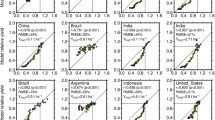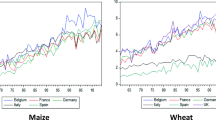Abstract
This paper projects the race between technologically driven increases in crop yields and changing climatic conditions in the central USA, one of the world’s most productive agricultural regions. Using the highest, average, and lowest decadal rates of technologically driven increases in crop yields over the 1980 to 2017 period, we develop spatially explicit yield scenarios to the end of the twenty-first century under RCP4.5 and RCP8.5. We find that with static technological innovation, severe climate change will decrease yields by an average of 22.4% (26.1 bu. ac−1) for maize, 27.9% (8.83 bu. ac−1) for soybeans, and 20% (7.14 bu. ac−1) for winter wheat in the central USA; however, with even the lowest rates of technological yield growth, yields increase by an average of 25.0% (40.5 bu. ac−1) for maize and 30.2% (14.2 bu. ac−1) for soybeans. We conclude that technology has the potential to overcome the negative impacts of climate change on the yields of maize, soybeans, and winter wheat in the central USA, but if these increases are to be environmentally sustainable, technological developments must be information-intensive rather than input-intensive.






Similar content being viewed by others
References
Alston JM, Anderson MA, James JS, Pardey PG (2010) Persistence pays: U.S. agricultural productivity growth and the Benefits from Public R&D Spending. Springer, New York
Amundson R, Berhe AA, Hopmans JW, Olson C, Sztein AE, Sparks DL (2015) Soil and human security in the 21st century. Science 348:1261071–1261071
Attavanich W, McCarl BA (2014) How is CO 2 affecting yields and technological progress? A statistical analysis. Clim Chang 124(4):747–762
Bador M, Donat MG, Geoffroy O, Alexander LV (2018) Assessing the robustness of future extreme precipitation intensification in the CMIP5 ensemble. J Clim 31:6505–6525. https://doi.org/10.1175/JCLI-D-17-0683.1
Bentsen M et al (2013) The Norwegian earth system model, NorESM1-M – part I: description and basic evaluation of the physical climate. Geosci Model Dev 6:687–720. https://doi.org/10.5194/gmd-6-687-2013
Bita CE, Gerats T (2013) Plant tolerance to high temperature in a changing environment: scientific fundamentals and production of heat stress-tolerant crops. Front Plant Sci. https://doi.org/10.3389/fpls.2013.00273
Blanc É (2017) Statistical emulators of maize, rice, soybean and wheat yields from global gridded crop models. Agricultural and Forest Meteorology 236:145–161
Blanc E, & Sultan B (2015) Emulating maize yields from global gridded crop models using statistical estimates. Agricultural and Forest Meteorology 214, 134–147
Bongiovanni R, Lowenberg-Deboer J (2004) Precision agriculture and sustainability. Precis Agric 5:359–387
Brookes G, Barfoot P (2016) GM crops: global socio-economic and environmental impacts 1996–2014. PG Economics Ltd, Dorchester
Cardinale BJ, Duffy JE, Gonzalez A, Hooper DU, Perrings C, Venail P, Naeem S (2012) Biodiversity loss and its impact on humanity. Nature 486(7401):59–67. https://doi.org/10.1038/nature11148
Challinor AJ, Watson J, Lobell DB, Howden SM, Smith DR, Chhetri N (2014) A meta-analysis of crop yield under climate change and adaptation. Nat Clim Chang 4:287–291
Corn and Soybean Digest, 2018. https://www.cornandsoybeandigest.com/soybeans/georgia-producer-sets-new-world-soybean-yield-record. Accessed 9–26-18
Craine JM, Elmore AJ, Wang L, Aranibar J, Bauters M, Boeckx P, Zmudczyńska-Skarbek K (2018) Isotopic evidence for oligotrophication of terrestrial ecosystems. Nature Ecology & Evolution 2(11):1735. https://doi.org/10.1038/s41559-018-0694-0
Dufresne J-L et al (2012) Climate change projections using the IPSL-CM5 earth system model: from CMIP3 to CMIP5. Clim Dyn 40:2123–2165. https://doi.org/10.1007/s00382-012-1636-1
Eilers PHC, Marx BD (1996) Flexible smoothing with B-splines and penalties. Stat Sci 11(2):89–121
Elser J, Bennett E (2011) Phosphorus cycle: a broken biogeochemical cycle. Nature 478:29–31
Evans LT (1993) Crop evolution, adaptation and yield. Cambridge University Press, Cambridge
Fargione JE, Plevin RJ, Hill JS (2010) The ecological impact of biofuels. Annu Rev Ecol Evol Syst 41:351–377. https://doi.org/10.1146/annurev-ecolsys-102209-144720
Farmer JD, LaFond F (2016) Hoe predictable is technological progress? Res Policy 45:647–665
Fischer, T., D. Byerlee, G. Edmeasdes, 2014. Crop yields and global food security. Australian Centre for International Agriculktural Research
Fuglie K (2017) R&D capital, R&D spillovers, and productivity growth in world agriculture. Appl Econ Perspect Policy 40(3):421–444. https://doi.org/10.1093/aepp/ppx045
Hillier J, Hawes C, Squire G, Hilton A, Wale S, Smith P (2009) The carbon footprint of food crop production. Int J Agric Sustain 7:107–118. https://doi.org/10.3763/ijas.2009.0419
Hooper DU, Adair EC, Cardinale BJ, Byrnes JEK, Hungate BA, Matulich KL et al (2012) A global synthesis reveals biodiversity loss as a major driver of ecosystem change. Nature 486(7401):105–108. https://doi.org/10.1038/nature111 https://doi.org/10.1111/j.1365-2664.2006.01270.x
James G, Witten D, Hastie T, Tibshirani R (2013) An introduction to statistical learning (Vol. 112, p. 18). Springer, New York
Khatodia, S., K. Bhatotia, N. Passricha, S.M.P. Khurana and N. Tuteja, 2016. The CRISPR/Cas Gemone-editing Tool: Application in Improvement of Crops. Front Plant Sci doi:https://doi.org/10.3389/pls.2016.00506
Knutti R, Masson D, Gettelman A (2013) Climate model genealogy: generation CMIP5 and how we got there. Geophys Res Lett 40:1194–1199
Konikow LF (2013) Groundwater depletion in the United States (1900−2008). US Geol Surv Sci Investig Rep 2013−5079:63 p. http://pubs.usgs.gov/sir/2013/5079
Liang XZ, You W, Chambers RG, Schmoldt DL, Gao W, Liu C, Liu YA, Sun C, Kennedy JA (2017) Determining climate effects on US total agricultural productivity. Proc Natl Acad Sci 114(12), E2285–E2292. https://doi.org/10.1073/pnas.1615922114
Lobell DB, Schlenker W, Costa-Roberts J (2011) Climate trends and global crop production since 1980. Science 333:613–616
Mann CC (2018) The wizard and the prophet. Knopf, New York
Mascioli NR, Fiore AM, Previdi M, Correa M (2016) Temperature and precipitation extremes in the United States: quantifying the responses to anthropogenic aerosols and greenhouse gases. J Clim 29:2689–2701. https://doi.org/10.1175/JCLI-D-15-0478.1
Mesonet. (2017). agweather connection. [online] Available at: https://www.mesonet.org/mesonet_connection/V2_No8.pdf [Accessed 2 Nov. 2017]
Miller, P., Lanier, W., and Brandt, S. (2001). Using growing degree days to predict plant stages. AgExtension Commun. Coord. Communication. Serv. Mont. State Univ.-Bozeman Bozeman MT.
Moore FC, Lantz U, Baldos C, Hertel T (2017) Economic impacts of climate change on agriculture: a comparison of process-based and statistical yield models. Environ Res Lett 12:065008
National Corn Growers Association 2018. https://www.dtnpf.com/agriculture/web/ag/news/crops/article/2017/12/19/hula-sets-new-world-corn-yield-542 . Accessed 5–26-18
NDAWN: North Dakota Agricultural Weather Network. (2017). Corn Growing Degree Days. [online] Available at: https://ndawn.ndsu.nodak.edu/help-corn-growing-degree-days.html [Accessed 2 Nov. 2017]
PRISM Climate Group (2004). PRISM Climate Data. Available at: http://www.prism.oregonstate.edu/
R Core Team (2017). R: a language and environment for statistical computing. R Foundation for statistical computing, Vienna, Austria. URL https://www.R-project.org/
Rabalais NN, Turner RE, Wiseman WJ Jr (2002) Gulf of Mexico hypoxia, a.K.a. “the dead zone”. Annu Rev Ecol Syst 33:235–263
Ramakutty N, Evan AT, Manfreda C, Foley JA (2008) Farming the planet: 1. Geographic distribution of global agricultural lands in the year 2000. Glob Biogeochem Cycles. https://doi.org/10.1029/2007GB002952
Ray DK, Ramankutty N, Mueller ND, West PC, Foley JA (2012) Recent patterns of crop yield growth and stagnation. Nat Commun 3(1). https://doi.org/10.1038/ncomms2296
Ray DK, Gerber JS, MacDonald GK, West PC (2015) Climate variation explans a third of global crop yield variability. Nat Commun 6. https://doi.org/10.1038/ncomms6989
Rocheta E, Sugiyanto M, Johnson F, Evans J, Sharma A (2014) How well do general circulation models represent low-frequency variability? Water Resour Res 50:2108–2123
Rockström J, Steffen W, Noone K, Persson Å, Chapin FS, Lambin EF, Foley JA (2009) A safe operating space for humanity. Nature 461(7263):472–475. https://doi.org/10.1038/461472a
Rosenzwieg C, Tubiello FN, Goldberg R, Mills E, Bloomfield J (2002) Increased crop damage in the US from excess precipitation under climate change. Glob Environ Chang 12:197–202
Schauberger B, Archontoulis S, Arneth A, Balkovic J, Ciais P, Deryng D, Elliott J, Folberth C, Khabarov N, Müller C et al (2017) Consistent negative response of US crops to high temperatures in observations and crop models. Nat Commun 8:13931
Schlenker W, Roberts MJ (2009) Nonlinear temperature effects indicate severe damages to US crop yields under climate change. Proc Natl Acad Sci 106:15594–15598
Schlesinger WH, Bernhardt ES (2013) Biogeochemistry: an analysis of global change. Academic Press, San Diego, CA
Schoof JT (2015) High-resolution projections of 21st century daily precipitation for the contiguous U.S. J Geophys Res-Atmos 120:3029–3042
Schoof JT, Pryor SC, Robeson SM (2007) Downscaling daily maximum and minimum temperatures in the Midwestern USA: a hybrid empirical approach. Int J Climatol 27:439–454
Stoebner TJ, Lant CL (2014) Geographic determinants of rural land covers and the agricultural margin in the Central United States. Appl Geogr 55:138–154
Swift MJ, Izac A-MN, van Noordwijk M (2004) Biodiversity and ecosystem services in agricultural landscapes—are we asking the right questions? Agriculture. Ecosyst Environ 104(1):113–134. https://doi.org/10.1016/j.agee.2004.01.013
Tainter, JAD, Strumsky, TG Taylor, M Arnold, J Lobo 2018. Depletion vs. innovation: the fundamental question of sustainability. Pp65-93 in Burlando, R and A. Tartaglia (eds.) Physical Limits to Economic Growth: Perspectives of economic, social, and complexity science. Routledge: New York
Tester M, Landridge P (2010) Breeding technologies to increase crop production in a changing world. Science 327:818–822
Tilman D, Balzer C, Hill J, Befort BL (2011) Global food demand and the sustainable intensification of agriculture. Proc Natl Acad Sci 108:20260–20264. https://doi.org/10.1073/pnas.1116437108
Troy TJ, Kipgen C, Pal I (2015) The impact of climate extremes and irrigation on US crop yields. Environ Res Lett 10(5):054013. https://doi.org/10.1088/1748-9326/10/5/054013
USDA-FAS, United States Departmental of Agriculture, Foreign Agricultural Service. (2017). Grain: World Markets and Trade
USDA National Agricultural Statistics Service Cropland Data Layer. 2019. Published crop-specific data layer [Online]. Available at https://nassgeodata.gmu.edu/CropScape/. (Accessed August 2018). USDA-NASS, Washington, DC.
USGCRP (2017) In: Wuebbles DJ, Fahey DW, Hibbard KA, Dokken DJ, Stewart BC, Maycock TK (eds) Climate science special report: fourth National Climate Assessment, volume 1. U.S. Global Change Research Program, Washington, DC, 470pp
Svitashev S, Schwartz C, Lenderts B, Young JK, & Cigan AM (2016) Genome editing in maize directed by CRISPR–Cas9 ribonucleoprotein complexes. Nature communications 7, 13274
van Vuuren DP et al (2011) The representative concentration pathways: an overview. Clim Chang 109:5–31. https://doi.org/10.1007/s10584-011-0148-z
Wang S, Heisey P, Schimmelpfennig D, Ball, E (2015) Agricultural productivity growth in the United States: Measurement, trends, and drivers. USDA Economic Research Report No. (ERR-189). https://www.ers.usda.gov/publications/pub-details/?pubid=45390
Wilks DS (1999) Multisite downscaling of daily precipitation with a stochastic weather generator. Clim Res 11:125–136
Wood SN (2011) Fast stable restricted maximum likelihood and marginal likelihood estimation of semiparametric generalized linear models. J Royal Stat Soc(B) 73(1):3–36
Yukimoto S et al (2012) A new global climate model of the meteorological research institute: MRI-CGCM3 – model description and basic performance. J Meteorol Soc Jpn 90A:23–64
Zhang W, Ricketts TH, Kremen C, Carney K, Swinton SM (2007) Ecosystem services and dis-services to agriculture. Ecol Econ 64(2):253–260. https://doi.org/10.1016/j.ecolecon.2007.02.024
Zhao C, Liu B, Piao S, Wang X, Lobell DB, Huang Y, ... & Durand JL. (2017). Temperature increase reduces global yields of major crops in four independent estimates. Proceedings of the National Academy of Sciences, 114(35), 9326–9331.
Author information
Authors and Affiliations
Corresponding author
Additional information
Publisher’s note
Springer Nature remains neutral with regard to jurisdictional claims in published maps and institutional affiliations.
Electronic supplementary material
ESM 1
(DOCX 90 kb)
Rights and permissions
About this article
Cite this article
Burchfield, E., Matthews-Pennanen, N., Schoof, J. et al. Changing yields in the Central United States under climate and technological change. Climatic Change 159, 329–346 (2020). https://doi.org/10.1007/s10584-019-02567-7
Received:
Accepted:
Published:
Issue Date:
DOI: https://doi.org/10.1007/s10584-019-02567-7




